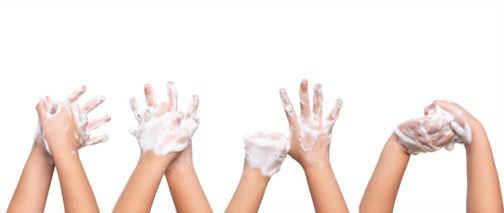
In this new age of coronavirus, we are told over and over to wash our hands after touching…just about anything. And not just with water. With soap and water. What is it about soap that makes it a perfect foil for the virus?
First of all, most viruses, including the coronavirus, are between 50-200 nanometers in size; as nanoparticles they are able to go everywhere. Second, viruses are not living things. They consist of three key building blocks all working in tandem: RNA, proteins and lipids. Each of these blocks has a job to do to carry out their nefarious mission.
- The RNA is the viral genetic material — it is similar to DNA.
- Proteins have several roles, including breaking into the target cell, assisting with virus replication and basically being a key building block (like a brick in a house) in the virus structure.
- The virus is held together by a combination of hydrogen bonds (like those in water) and lipids (fats) that allow the virus to stay on surfaces for a long time for maximum effectiveness. The surface of fibers or wood, for instance, can form bonds with the virus, which is why you should be very careful when you bring packages in from your front stoop.
Palli Thordarson, professor at the School of Chemistry at the University of New South Wales, Sydney, explains how the virus works in the body. “When a virus invades a cell, the RNA “hijacks” the cellular machinery like a computer virus and forces the cell to make fresh copies of its own RNA and the various proteins that make up the virus.”
Your skin is an ideal surface for a virus. Since your hands are the doers—feeling and scratching and poking and touching hundreds of times a day—they are constantly in harm’s way. Because of the composition of the virus, it can stick to your hands like Velcro. But there is a way to rip that Velcro apart and render it harmless. It’s not new technology—it’s been around for hundreds of years. It’s soap!
How soap destroys coronavirus
The first thing to understand is that you don’t “kill” the virus when washing your hands. You “deactivate” it by taking it apart. Handwashing is one of the best ways to protect yourself and your family from getting sick.
Soap contains fat-like substances known as amphiphiles, some structurally similar to the lipids in the virus membrane. The soap molecules neutralize the lipids in the virus membranes, making them unable to stick. Soap effectively “dissolves” the glue that holds the virus together; the water washes it away. It physically deactivates the virus, so it can’t bind to and enter human cells anymore.
How long should we wash?
Evidence suggests that washing hands for about 20-30 seconds removes more germs from hands than washing for shorter periods. Twenty seconds is the recommended minimum time to wash. The longer the wash, the more virus lipids you’ll deactivate. Be careful not to scrub your skin raw; that will create cracks and openings in your skin that open you to a wide range of other infections.
What about just water?
Washing only with water doesn’t work. You need the lipids that soap provides to overpower the lipids that the virus needs to stick. Water alone isn’t enough.
This video shows that washing your hands with soap and water for 20 seconds totally removes coronavirus from your skin.
Video: How soap kills the coronavirus
How to wash your hands
Follow these five steps every time.
-
- Wet your hands with clean, running water (warm or cold), turn off the tap, and apply soap.
- Lather your hands by rubbing them together with the soap. Lather the backs of your hands, between your fingers, and under your nails.
- Wash your hands for at least 20 seconds—between fingers, back of hand, fingers, thumb, wrist. Need a timer? Hum the “Happy Birthday” song from beginning to end twice. Wash them as if you have been gardening with your hands.
- Rinse your hands well under clean, running water.
- Dry your hands using a clean towel or air dry them.
- Moisturize your hands to prevent them from drying and cracking. You don’t want to let other nasty germs like staphylococcus into your body.
This video shows how to thoroughly wash your hands.
Video: Coronavirus–How to wash your hands
How to use disposable gloves to prevent coronavirus infection
Wearing protective gloves to protect yourself from the coronavirus may not be the solution you think it is. These gloves are intended for one-time medical use: put on gloves, examine patient, remove gloves and throw away. New patient, new gloves. The reason for this is that the virus can stick to the gloves, perhaps even more than your hands.
Learn how to properly put on and remove gloves to ensure you protect yourself from infection.
If you still want to wear gloves, for a trip to the supermarket, for example, then it is important to know how to properly put them on and take them off. As you’ll see in the video, there is a specific way to remove the gloves so you don’t infect yourself, and the gloves roll up into ball that can be tossed in a trash can.
Video: Using Gloves to Prevent Coronavirus from Being Transmitted
Watch the video: Wash your hands. Put on fresh pair of gloves. Complete your task. Do not touch your face. Remove gloves and dispose of them properly.
* * *
You may also like
- What 60-somethings need to know about the coronavirus
- Books for binge reading, perfect in a time of stay-at-home
- How to boost your immunity if you’re over 60
Go to the BLUE HARE home page for more articles for fabulous women
